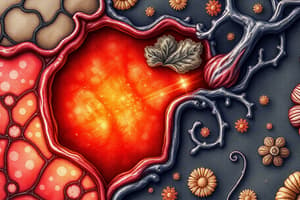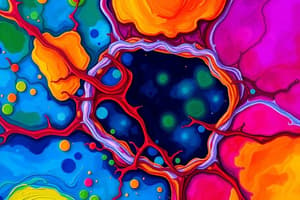Podcast
Questions and Answers
Which of the following events occurs first when the dermis is penetrated?
Which of the following events occurs first when the dermis is penetrated?
- Regeneration of the epithelium
- Arrival of immune cells
- Leakage of blood into the wound (correct)
- Formation of granulation tissue
Platelets contribute to stopping bleeding by inhibiting clot formation.
Platelets contribute to stopping bleeding by inhibiting clot formation.
False (B)
What type of tissue primarily comprises scar tissue?
What type of tissue primarily comprises scar tissue?
collagen fibers
Following the formation of a blood clot, more ______ cells arrive to help clean the wound and reduce the risk of infection.
Following the formation of a blood clot, more ______ cells arrive to help clean the wound and reduce the risk of infection.
Which cells work to replace damaged collagen fibers during wound healing?
Which cells work to replace damaged collagen fibers during wound healing?
Scar tissue contains neurons and glands, allowing it to fully restore the normal function of the skin.
Scar tissue contains neurons and glands, allowing it to fully restore the normal function of the skin.
What is the term for the dried-up blood clot that appears on the surface of healing skin?
What is the term for the dried-up blood clot that appears on the surface of healing skin?
In which layer of the integument is scar tissue observed after wound healing?
In which layer of the integument is scar tissue observed after wound healing?
__________ assist with early phagocytosis to remove bacteria introduced from the environment during a skin wound.
__________ assist with early phagocytosis to remove bacteria introduced from the environment during a skin wound.
Match the component with its role in wound healing
Match the component with its role in wound healing
Flashcards
Wound Healing: Step One
Wound Healing: Step One
Blood vessels are damaged, leading to blood leakage. Leukocytes help with early phagocytosis to remove bacteria.
Wound Healing: Step Two
Wound Healing: Step Two
Platelets plug broken vessels, facilitating clot formation. This ensures bleeding stops and more immune cells arrive.
Wound Healing: Step Three
Wound Healing: Step Three
Fibroblasts replace damaged collagen fibers, blood vessels regrow, and granulation tissue forms for epidermal regeneration.
Wound Healing: Step Four
Wound Healing: Step Four
Signup and view all the flashcards
Thrombocytes Role
Thrombocytes Role
Signup and view all the flashcards
Scab
Scab
Signup and view all the flashcards
Granulation Tissue
Granulation Tissue
Signup and view all the flashcards
Study Notes
-
Bleeding occurs when the dermis is penetrated, damaging blood vessels
-
Leukocytes aid early phagocytosis, removing bacteria from the wound
-
Thrombocytes (platelets) plug broken vessels and facilitate clot formation
-
Clots halt bleeding, attract immune cells to clean the wound, and lower infection risk
-
Fibroblasts replace damaged collagen fibers and blood vessels regrow
-
Granulation tissue forms where the epidermis regenerates
-
Epithelium regenerates, sealing the wound
-
Scar tissue (fibrosis) appears in the dermis, consisting mainly of collagen fibers, it lacks neurons and glands, extensive scarring can impair skin function
-
Fibroblasts continue repairing the papillary and reticular layers of the dermis
-
A scab (dried blood clot) appears on the skin's surface
Studying That Suits You
Use AI to generate personalized quizzes and flashcards to suit your learning preferences.




